Monopolistic Competition and Oligopoly Markets: A Detailed Report
VerifiedAdded on 2023/04/04
|10
|2748
|438
Report
AI Summary
This report provides an in-depth analysis of monopolistic competition and oligopoly market structures, highlighting their key characteristics and differences. It examines the strategic interactions within oligopolies, focusing on how firms like McDonald's and Burger King compete. The report also discusses monopolistic competition, emphasizing product differentiation and market dynamics, using the beverage industry as an example. Through case studies of McDonald's and Starbucks, the report illustrates real-world applications of these market structures, demonstrating how companies navigate competition and pricing decisions. The analysis covers factors such as barriers to entry, price elasticity, and the impact of market changes on profitability, providing a comprehensive understanding of these imperfectly competitive markets. This report is available on Desklib, a platform offering a wealth of study resources for students.
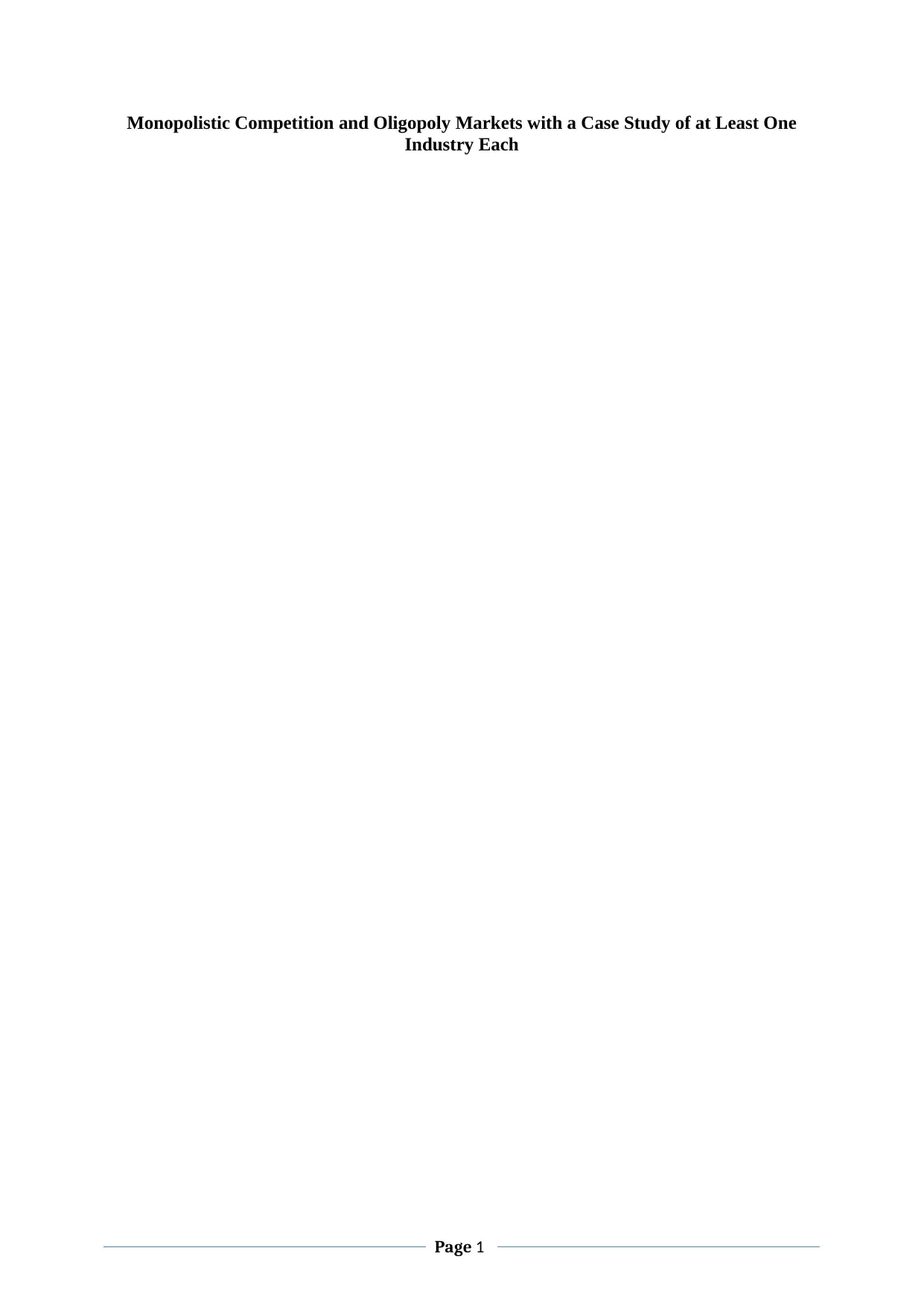
Monopolistic Competition and Oligopoly Markets with a Case Study of at Least One
Industry Each
Page 1
Industry Each
Page 1
Paraphrase This Document
Need a fresh take? Get an instant paraphrase of this document with our AI Paraphraser
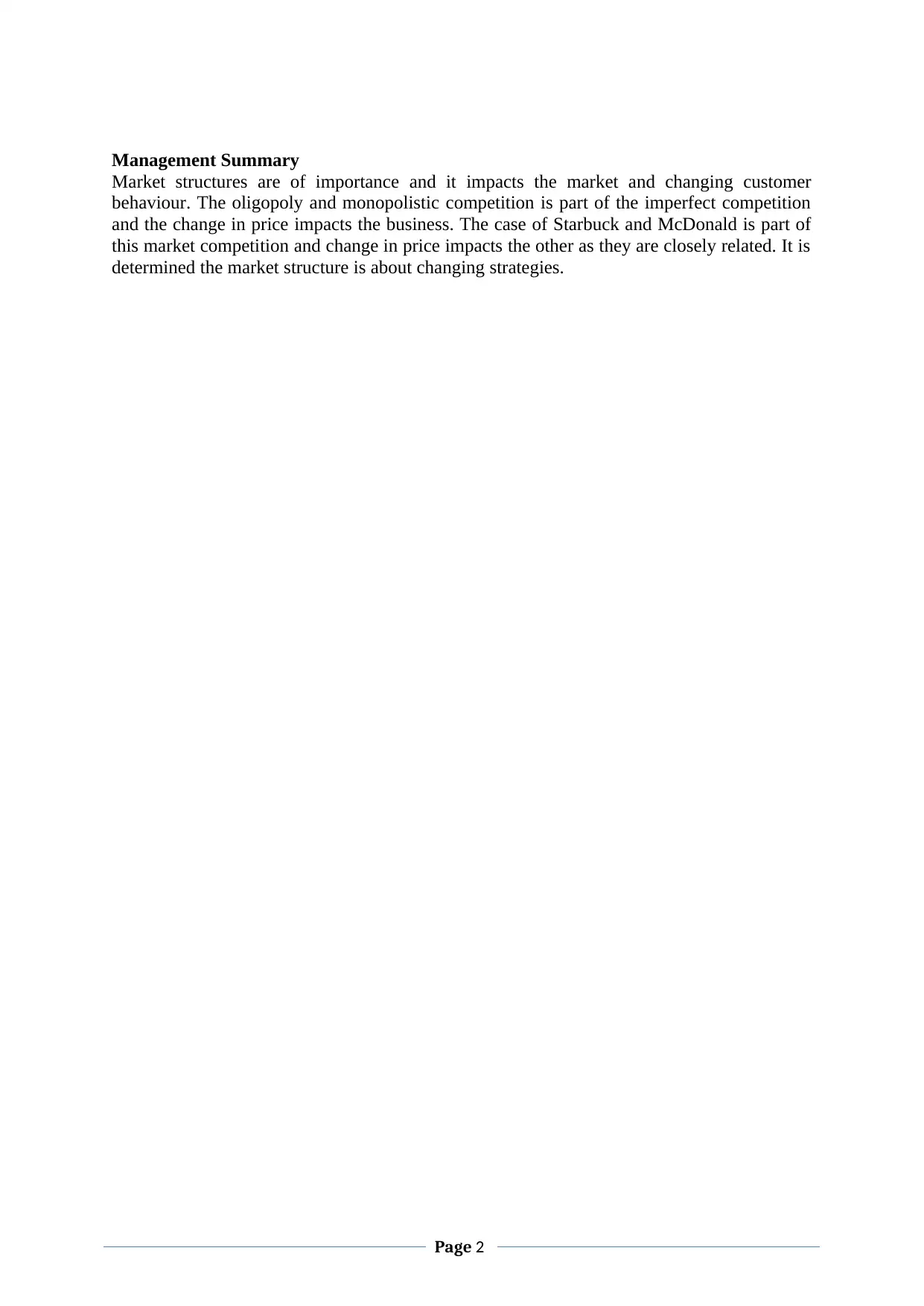
Management Summary
Market structures are of importance and it impacts the market and changing customer
behaviour. The oligopoly and monopolistic competition is part of the imperfect competition
and the change in price impacts the business. The case of Starbuck and McDonald is part of
this market competition and change in price impacts the other as they are closely related. It is
determined the market structure is about changing strategies.
Page 2
Market structures are of importance and it impacts the market and changing customer
behaviour. The oligopoly and monopolistic competition is part of the imperfect competition
and the change in price impacts the business. The case of Starbuck and McDonald is part of
this market competition and change in price impacts the other as they are closely related. It is
determined the market structure is about changing strategies.
Page 2
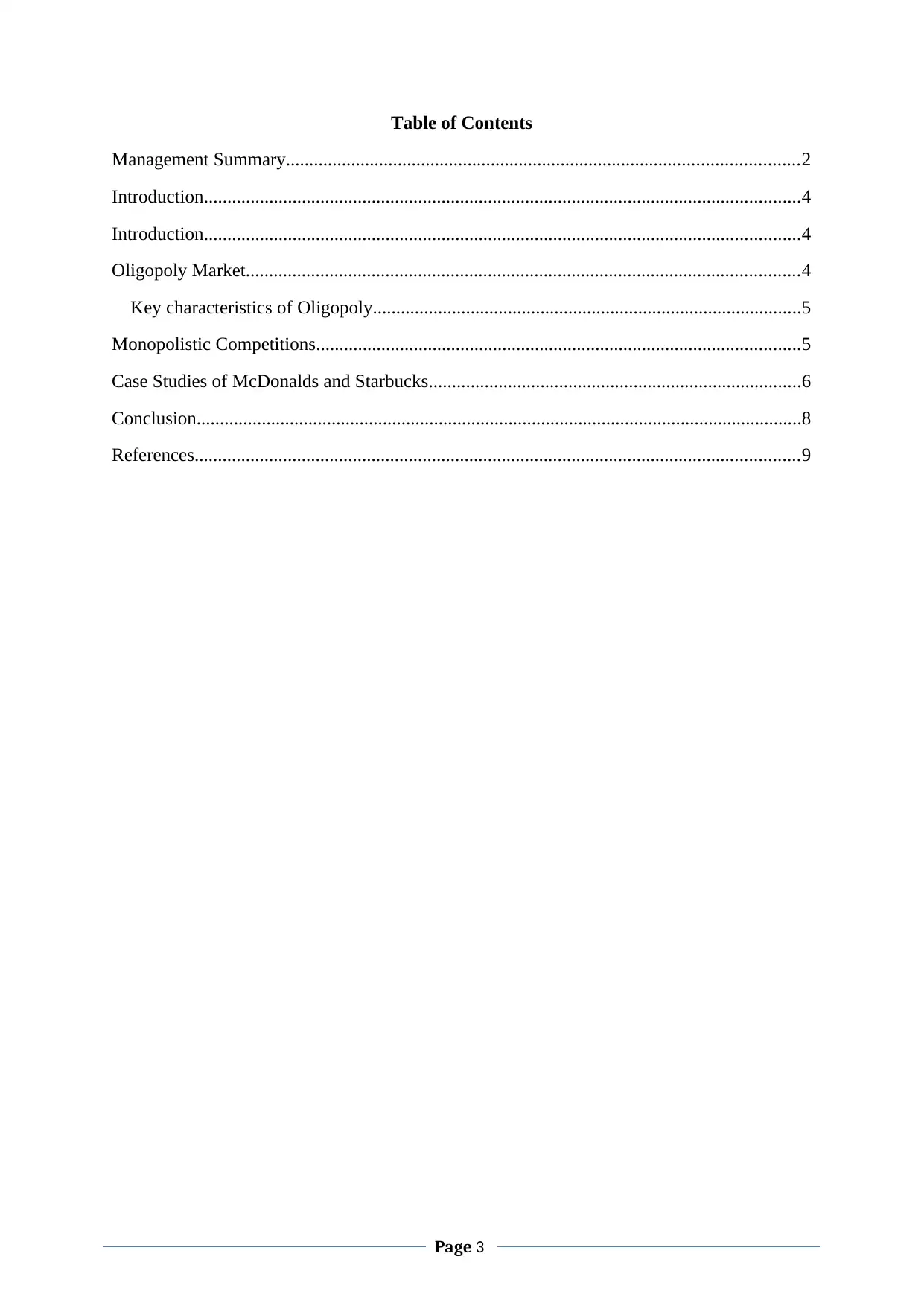
Table of Contents
Management Summary..............................................................................................................2
Introduction................................................................................................................................4
Introduction................................................................................................................................4
Oligopoly Market.......................................................................................................................4
Key characteristics of Oligopoly............................................................................................5
Monopolistic Competitions........................................................................................................5
Case Studies of McDonalds and Starbucks................................................................................6
Conclusion..................................................................................................................................8
References..................................................................................................................................9
Page 3
Management Summary..............................................................................................................2
Introduction................................................................................................................................4
Introduction................................................................................................................................4
Oligopoly Market.......................................................................................................................4
Key characteristics of Oligopoly............................................................................................5
Monopolistic Competitions........................................................................................................5
Case Studies of McDonalds and Starbucks................................................................................6
Conclusion..................................................................................................................................8
References..................................................................................................................................9
Page 3
⊘ This is a preview!⊘
Do you want full access?
Subscribe today to unlock all pages.

Trusted by 1+ million students worldwide
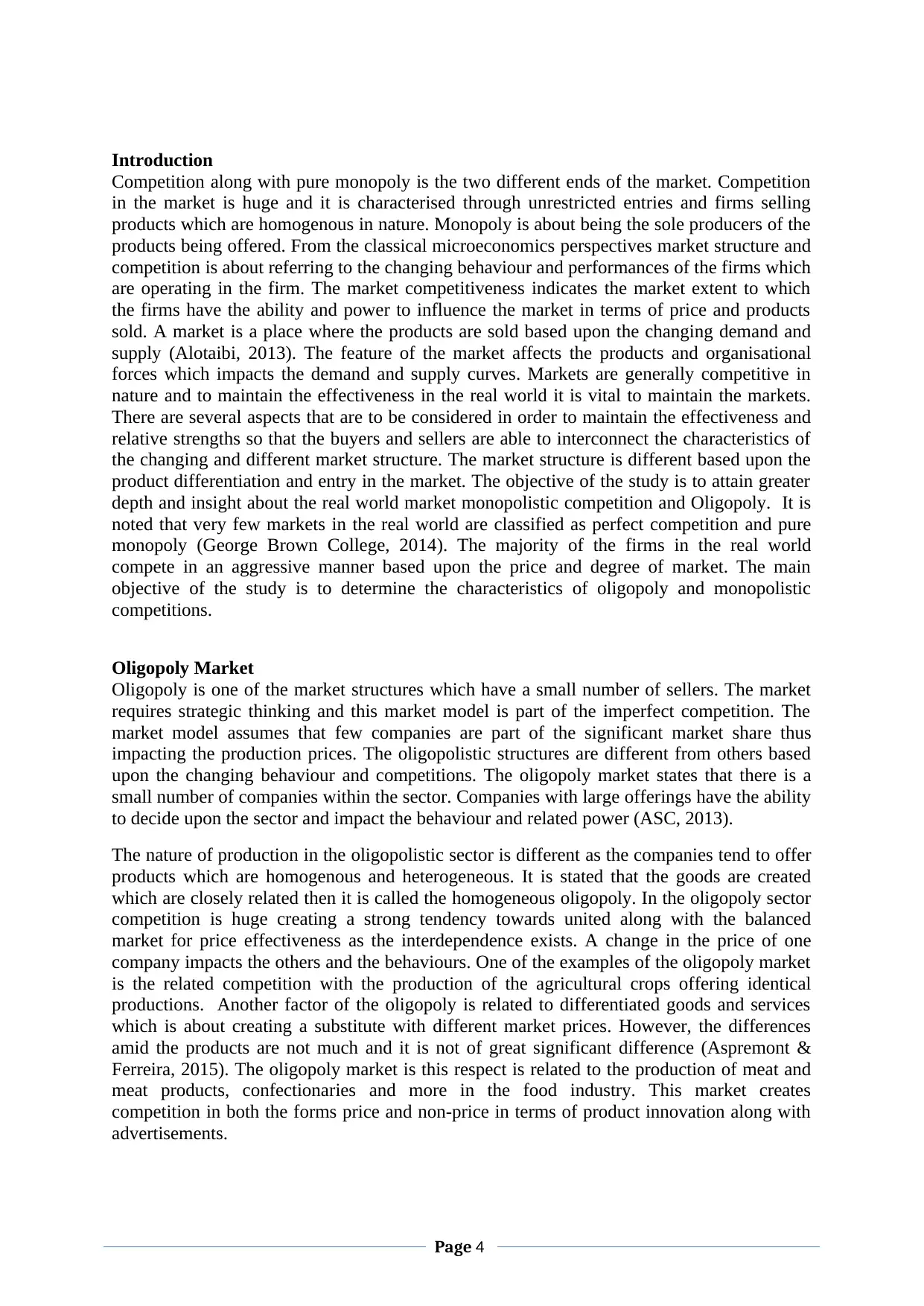
Introduction
Competition along with pure monopoly is the two different ends of the market. Competition
in the market is huge and it is characterised through unrestricted entries and firms selling
products which are homogenous in nature. Monopoly is about being the sole producers of the
products being offered. From the classical microeconomics perspectives market structure and
competition is about referring to the changing behaviour and performances of the firms which
are operating in the firm. The market competitiveness indicates the market extent to which
the firms have the ability and power to influence the market in terms of price and products
sold. A market is a place where the products are sold based upon the changing demand and
supply (Alotaibi, 2013). The feature of the market affects the products and organisational
forces which impacts the demand and supply curves. Markets are generally competitive in
nature and to maintain the effectiveness in the real world it is vital to maintain the markets.
There are several aspects that are to be considered in order to maintain the effectiveness and
relative strengths so that the buyers and sellers are able to interconnect the characteristics of
the changing and different market structure. The market structure is different based upon the
product differentiation and entry in the market. The objective of the study is to attain greater
depth and insight about the real world market monopolistic competition and Oligopoly. It is
noted that very few markets in the real world are classified as perfect competition and pure
monopoly (George Brown College, 2014). The majority of the firms in the real world
compete in an aggressive manner based upon the price and degree of market. The main
objective of the study is to determine the characteristics of oligopoly and monopolistic
competitions.
Oligopoly Market
Oligopoly is one of the market structures which have a small number of sellers. The market
requires strategic thinking and this market model is part of the imperfect competition. The
market model assumes that few companies are part of the significant market share thus
impacting the production prices. The oligopolistic structures are different from others based
upon the changing behaviour and competitions. The oligopoly market states that there is a
small number of companies within the sector. Companies with large offerings have the ability
to decide upon the sector and impact the behaviour and related power (ASC, 2013).
The nature of production in the oligopolistic sector is different as the companies tend to offer
products which are homogenous and heterogeneous. It is stated that the goods are created
which are closely related then it is called the homogeneous oligopoly. In the oligopoly sector
competition is huge creating a strong tendency towards united along with the balanced
market for price effectiveness as the interdependence exists. A change in the price of one
company impacts the others and the behaviours. One of the examples of the oligopoly market
is the related competition with the production of the agricultural crops offering identical
productions. Another factor of the oligopoly is related to differentiated goods and services
which is about creating a substitute with different market prices. However, the differences
amid the products are not much and it is not of great significant difference (Aspremont &
Ferreira, 2015). The oligopoly market is this respect is related to the production of meat and
meat products, confectionaries and more in the food industry. This market creates
competition in both the forms price and non-price in terms of product innovation along with
advertisements.
Page 4
Competition along with pure monopoly is the two different ends of the market. Competition
in the market is huge and it is characterised through unrestricted entries and firms selling
products which are homogenous in nature. Monopoly is about being the sole producers of the
products being offered. From the classical microeconomics perspectives market structure and
competition is about referring to the changing behaviour and performances of the firms which
are operating in the firm. The market competitiveness indicates the market extent to which
the firms have the ability and power to influence the market in terms of price and products
sold. A market is a place where the products are sold based upon the changing demand and
supply (Alotaibi, 2013). The feature of the market affects the products and organisational
forces which impacts the demand and supply curves. Markets are generally competitive in
nature and to maintain the effectiveness in the real world it is vital to maintain the markets.
There are several aspects that are to be considered in order to maintain the effectiveness and
relative strengths so that the buyers and sellers are able to interconnect the characteristics of
the changing and different market structure. The market structure is different based upon the
product differentiation and entry in the market. The objective of the study is to attain greater
depth and insight about the real world market monopolistic competition and Oligopoly. It is
noted that very few markets in the real world are classified as perfect competition and pure
monopoly (George Brown College, 2014). The majority of the firms in the real world
compete in an aggressive manner based upon the price and degree of market. The main
objective of the study is to determine the characteristics of oligopoly and monopolistic
competitions.
Oligopoly Market
Oligopoly is one of the market structures which have a small number of sellers. The market
requires strategic thinking and this market model is part of the imperfect competition. The
market model assumes that few companies are part of the significant market share thus
impacting the production prices. The oligopolistic structures are different from others based
upon the changing behaviour and competitions. The oligopoly market states that there is a
small number of companies within the sector. Companies with large offerings have the ability
to decide upon the sector and impact the behaviour and related power (ASC, 2013).
The nature of production in the oligopolistic sector is different as the companies tend to offer
products which are homogenous and heterogeneous. It is stated that the goods are created
which are closely related then it is called the homogeneous oligopoly. In the oligopoly sector
competition is huge creating a strong tendency towards united along with the balanced
market for price effectiveness as the interdependence exists. A change in the price of one
company impacts the others and the behaviours. One of the examples of the oligopoly market
is the related competition with the production of the agricultural crops offering identical
productions. Another factor of the oligopoly is related to differentiated goods and services
which is about creating a substitute with different market prices. However, the differences
amid the products are not much and it is not of great significant difference (Aspremont &
Ferreira, 2015). The oligopoly market is this respect is related to the production of meat and
meat products, confectionaries and more in the food industry. This market creates
competition in both the forms price and non-price in terms of product innovation along with
advertisements.
Page 4
Paraphrase This Document
Need a fresh take? Get an instant paraphrase of this document with our AI Paraphraser
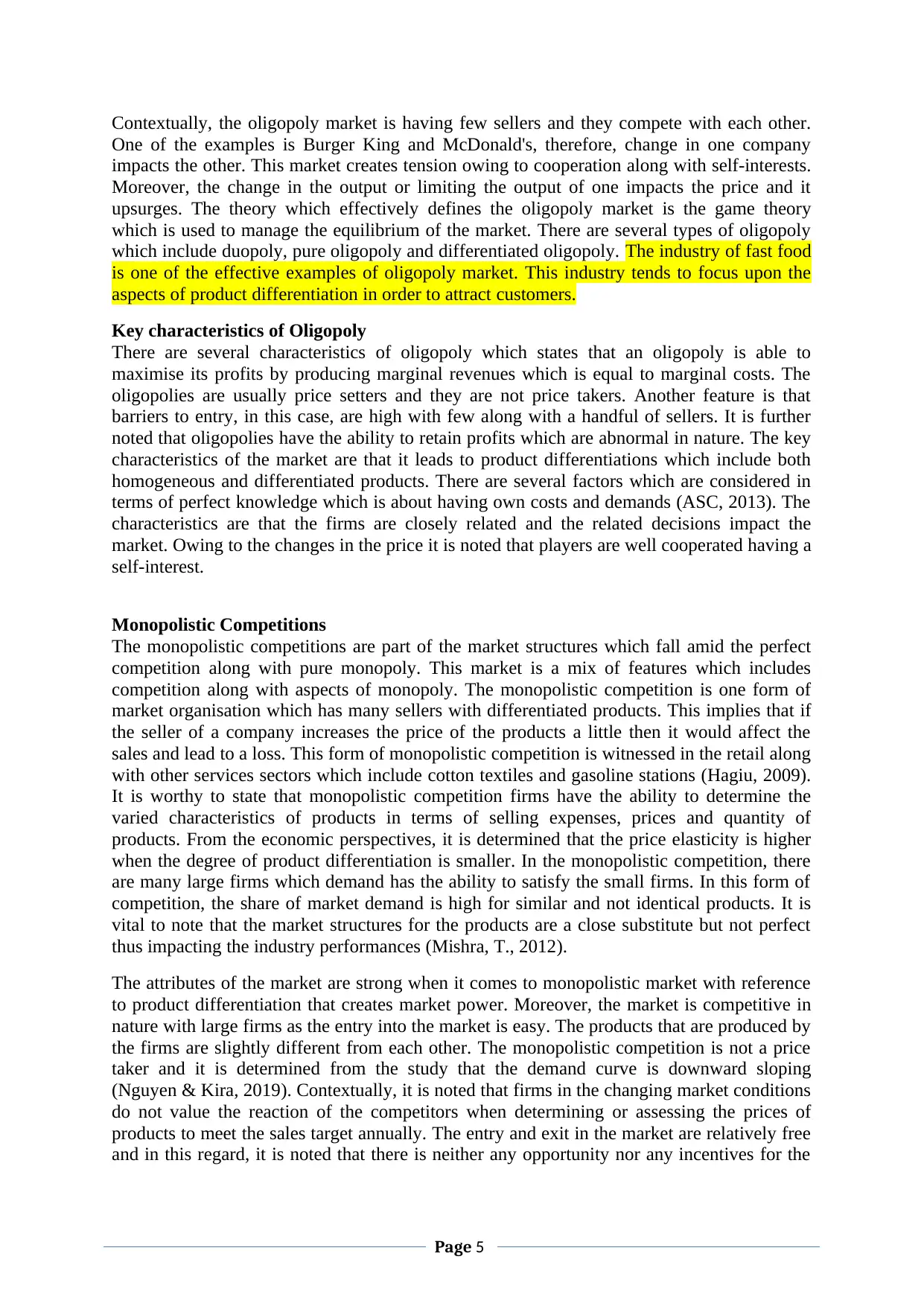
Contextually, the oligopoly market is having few sellers and they compete with each other.
One of the examples is Burger King and McDonald's, therefore, change in one company
impacts the other. This market creates tension owing to cooperation along with self-interests.
Moreover, the change in the output or limiting the output of one impacts the price and it
upsurges. The theory which effectively defines the oligopoly market is the game theory
which is used to manage the equilibrium of the market. There are several types of oligopoly
which include duopoly, pure oligopoly and differentiated oligopoly. The industry of fast food
is one of the effective examples of oligopoly market. This industry tends to focus upon the
aspects of product differentiation in order to attract customers.
Key characteristics of Oligopoly
There are several characteristics of oligopoly which states that an oligopoly is able to
maximise its profits by producing marginal revenues which is equal to marginal costs. The
oligopolies are usually price setters and they are not price takers. Another feature is that
barriers to entry, in this case, are high with few along with a handful of sellers. It is further
noted that oligopolies have the ability to retain profits which are abnormal in nature. The key
characteristics of the market are that it leads to product differentiations which include both
homogeneous and differentiated products. There are several factors which are considered in
terms of perfect knowledge which is about having own costs and demands (ASC, 2013). The
characteristics are that the firms are closely related and the related decisions impact the
market. Owing to the changes in the price it is noted that players are well cooperated having a
self-interest.
Monopolistic Competitions
The monopolistic competitions are part of the market structures which fall amid the perfect
competition along with pure monopoly. This market is a mix of features which includes
competition along with aspects of monopoly. The monopolistic competition is one form of
market organisation which has many sellers with differentiated products. This implies that if
the seller of a company increases the price of the products a little then it would affect the
sales and lead to a loss. This form of monopolistic competition is witnessed in the retail along
with other services sectors which include cotton textiles and gasoline stations (Hagiu, 2009).
It is worthy to state that monopolistic competition firms have the ability to determine the
varied characteristics of products in terms of selling expenses, prices and quantity of
products. From the economic perspectives, it is determined that the price elasticity is higher
when the degree of product differentiation is smaller. In the monopolistic competition, there
are many large firms which demand has the ability to satisfy the small firms. In this form of
competition, the share of market demand is high for similar and not identical products. It is
vital to note that the market structures for the products are a close substitute but not perfect
thus impacting the industry performances (Mishra, T., 2012).
The attributes of the market are strong when it comes to monopolistic market with reference
to product differentiation that creates market power. Moreover, the market is competitive in
nature with large firms as the entry into the market is easy. The products that are produced by
the firms are slightly different from each other. The monopolistic competition is not a price
taker and it is determined from the study that the demand curve is downward sloping
(Nguyen & Kira, 2019). Contextually, it is noted that firms in the changing market conditions
do not value the reaction of the competitors when determining or assessing the prices of
products to meet the sales target annually. The entry and exit in the market are relatively free
and in this regard, it is noted that there is neither any opportunity nor any incentives for the
Page 5
One of the examples is Burger King and McDonald's, therefore, change in one company
impacts the other. This market creates tension owing to cooperation along with self-interests.
Moreover, the change in the output or limiting the output of one impacts the price and it
upsurges. The theory which effectively defines the oligopoly market is the game theory
which is used to manage the equilibrium of the market. There are several types of oligopoly
which include duopoly, pure oligopoly and differentiated oligopoly. The industry of fast food
is one of the effective examples of oligopoly market. This industry tends to focus upon the
aspects of product differentiation in order to attract customers.
Key characteristics of Oligopoly
There are several characteristics of oligopoly which states that an oligopoly is able to
maximise its profits by producing marginal revenues which is equal to marginal costs. The
oligopolies are usually price setters and they are not price takers. Another feature is that
barriers to entry, in this case, are high with few along with a handful of sellers. It is further
noted that oligopolies have the ability to retain profits which are abnormal in nature. The key
characteristics of the market are that it leads to product differentiations which include both
homogeneous and differentiated products. There are several factors which are considered in
terms of perfect knowledge which is about having own costs and demands (ASC, 2013). The
characteristics are that the firms are closely related and the related decisions impact the
market. Owing to the changes in the price it is noted that players are well cooperated having a
self-interest.
Monopolistic Competitions
The monopolistic competitions are part of the market structures which fall amid the perfect
competition along with pure monopoly. This market is a mix of features which includes
competition along with aspects of monopoly. The monopolistic competition is one form of
market organisation which has many sellers with differentiated products. This implies that if
the seller of a company increases the price of the products a little then it would affect the
sales and lead to a loss. This form of monopolistic competition is witnessed in the retail along
with other services sectors which include cotton textiles and gasoline stations (Hagiu, 2009).
It is worthy to state that monopolistic competition firms have the ability to determine the
varied characteristics of products in terms of selling expenses, prices and quantity of
products. From the economic perspectives, it is determined that the price elasticity is higher
when the degree of product differentiation is smaller. In the monopolistic competition, there
are many large firms which demand has the ability to satisfy the small firms. In this form of
competition, the share of market demand is high for similar and not identical products. It is
vital to note that the market structures for the products are a close substitute but not perfect
thus impacting the industry performances (Mishra, T., 2012).
The attributes of the market are strong when it comes to monopolistic market with reference
to product differentiation that creates market power. Moreover, the market is competitive in
nature with large firms as the entry into the market is easy. The products that are produced by
the firms are slightly different from each other. The monopolistic competition is not a price
taker and it is determined from the study that the demand curve is downward sloping
(Nguyen & Kira, 2019). Contextually, it is noted that firms in the changing market conditions
do not value the reaction of the competitors when determining or assessing the prices of
products to meet the sales target annually. The entry and exit in the market are relatively free
and in this regard, it is noted that there is neither any opportunity nor any incentives for the
Page 5
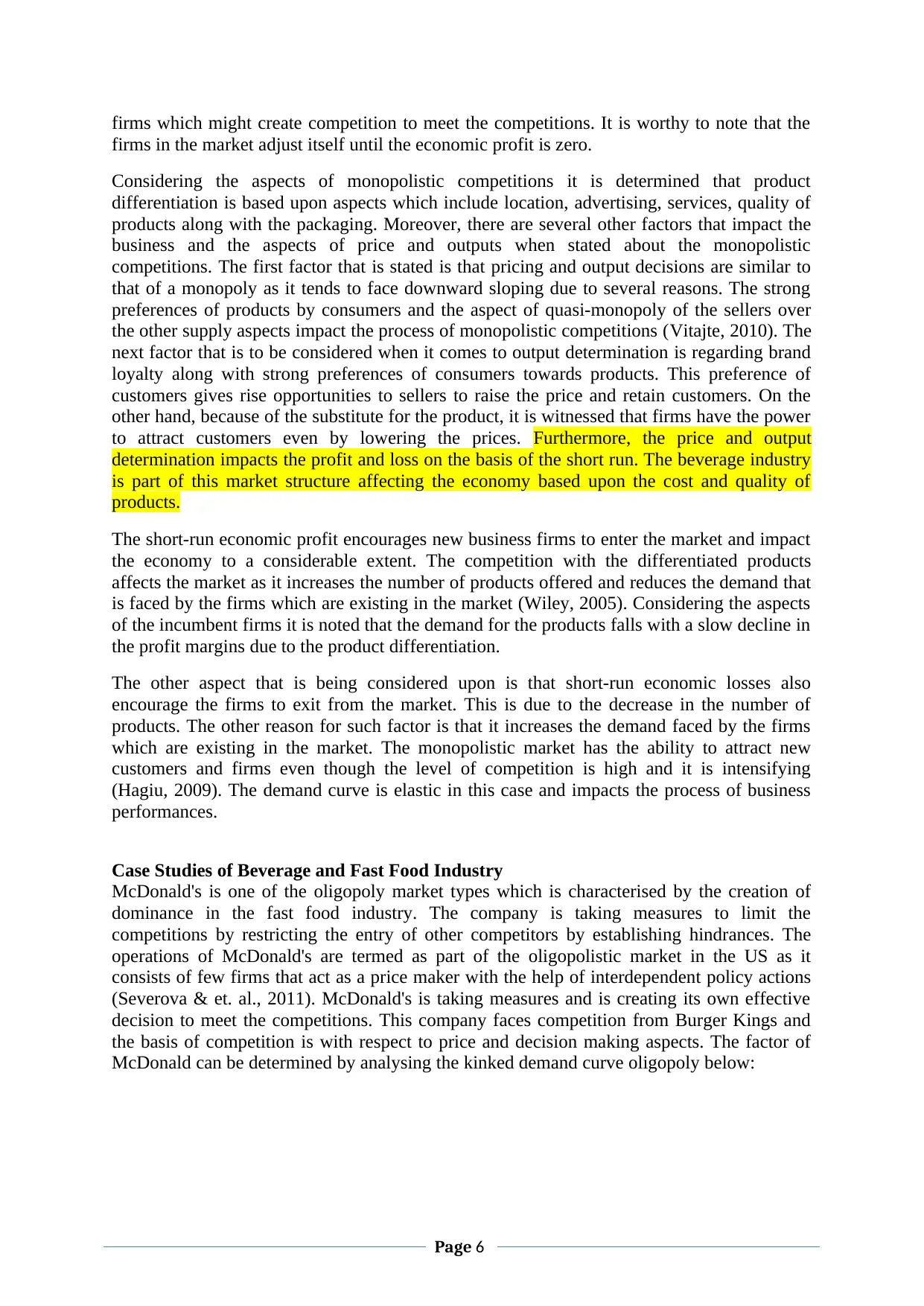
firms which might create competition to meet the competitions. It is worthy to note that the
firms in the market adjust itself until the economic profit is zero.
Considering the aspects of monopolistic competitions it is determined that product
differentiation is based upon aspects which include location, advertising, services, quality of
products along with the packaging. Moreover, there are several other factors that impact the
business and the aspects of price and outputs when stated about the monopolistic
competitions. The first factor that is stated is that pricing and output decisions are similar to
that of a monopoly as it tends to face downward sloping due to several reasons. The strong
preferences of products by consumers and the aspect of quasi-monopoly of the sellers over
the other supply aspects impact the process of monopolistic competitions (Vitajte, 2010). The
next factor that is to be considered when it comes to output determination is regarding brand
loyalty along with strong preferences of consumers towards products. This preference of
customers gives rise opportunities to sellers to raise the price and retain customers. On the
other hand, because of the substitute for the product, it is witnessed that firms have the power
to attract customers even by lowering the prices. Furthermore, the price and output
determination impacts the profit and loss on the basis of the short run. The beverage industry
is part of this market structure affecting the economy based upon the cost and quality of
products.
The short-run economic profit encourages new business firms to enter the market and impact
the economy to a considerable extent. The competition with the differentiated products
affects the market as it increases the number of products offered and reduces the demand that
is faced by the firms which are existing in the market (Wiley, 2005). Considering the aspects
of the incumbent firms it is noted that the demand for the products falls with a slow decline in
the profit margins due to the product differentiation.
The other aspect that is being considered upon is that short-run economic losses also
encourage the firms to exit from the market. This is due to the decrease in the number of
products. The other reason for such factor is that it increases the demand faced by the firms
which are existing in the market. The monopolistic market has the ability to attract new
customers and firms even though the level of competition is high and it is intensifying
(Hagiu, 2009). The demand curve is elastic in this case and impacts the process of business
performances.
Case Studies of Beverage and Fast Food Industry
McDonald's is one of the oligopoly market types which is characterised by the creation of
dominance in the fast food industry. The company is taking measures to limit the
competitions by restricting the entry of other competitors by establishing hindrances. The
operations of McDonald's are termed as part of the oligopolistic market in the US as it
consists of few firms that act as a price maker with the help of interdependent policy actions
(Severova & et. al., 2011). McDonald's is taking measures and is creating its own effective
decision to meet the competitions. This company faces competition from Burger Kings and
the basis of competition is with respect to price and decision making aspects. The factor of
McDonald can be determined by analysing the kinked demand curve oligopoly below:
Page 6
firms in the market adjust itself until the economic profit is zero.
Considering the aspects of monopolistic competitions it is determined that product
differentiation is based upon aspects which include location, advertising, services, quality of
products along with the packaging. Moreover, there are several other factors that impact the
business and the aspects of price and outputs when stated about the monopolistic
competitions. The first factor that is stated is that pricing and output decisions are similar to
that of a monopoly as it tends to face downward sloping due to several reasons. The strong
preferences of products by consumers and the aspect of quasi-monopoly of the sellers over
the other supply aspects impact the process of monopolistic competitions (Vitajte, 2010). The
next factor that is to be considered when it comes to output determination is regarding brand
loyalty along with strong preferences of consumers towards products. This preference of
customers gives rise opportunities to sellers to raise the price and retain customers. On the
other hand, because of the substitute for the product, it is witnessed that firms have the power
to attract customers even by lowering the prices. Furthermore, the price and output
determination impacts the profit and loss on the basis of the short run. The beverage industry
is part of this market structure affecting the economy based upon the cost and quality of
products.
The short-run economic profit encourages new business firms to enter the market and impact
the economy to a considerable extent. The competition with the differentiated products
affects the market as it increases the number of products offered and reduces the demand that
is faced by the firms which are existing in the market (Wiley, 2005). Considering the aspects
of the incumbent firms it is noted that the demand for the products falls with a slow decline in
the profit margins due to the product differentiation.
The other aspect that is being considered upon is that short-run economic losses also
encourage the firms to exit from the market. This is due to the decrease in the number of
products. The other reason for such factor is that it increases the demand faced by the firms
which are existing in the market. The monopolistic market has the ability to attract new
customers and firms even though the level of competition is high and it is intensifying
(Hagiu, 2009). The demand curve is elastic in this case and impacts the process of business
performances.
Case Studies of Beverage and Fast Food Industry
McDonald's is one of the oligopoly market types which is characterised by the creation of
dominance in the fast food industry. The company is taking measures to limit the
competitions by restricting the entry of other competitors by establishing hindrances. The
operations of McDonald's are termed as part of the oligopolistic market in the US as it
consists of few firms that act as a price maker with the help of interdependent policy actions
(Severova & et. al., 2011). McDonald's is taking measures and is creating its own effective
decision to meet the competitions. This company faces competition from Burger Kings and
the basis of competition is with respect to price and decision making aspects. The factor of
McDonald can be determined by analysing the kinked demand curve oligopoly below:
Page 6
⊘ This is a preview!⊘
Do you want full access?
Subscribe today to unlock all pages.

Trusted by 1+ million students worldwide
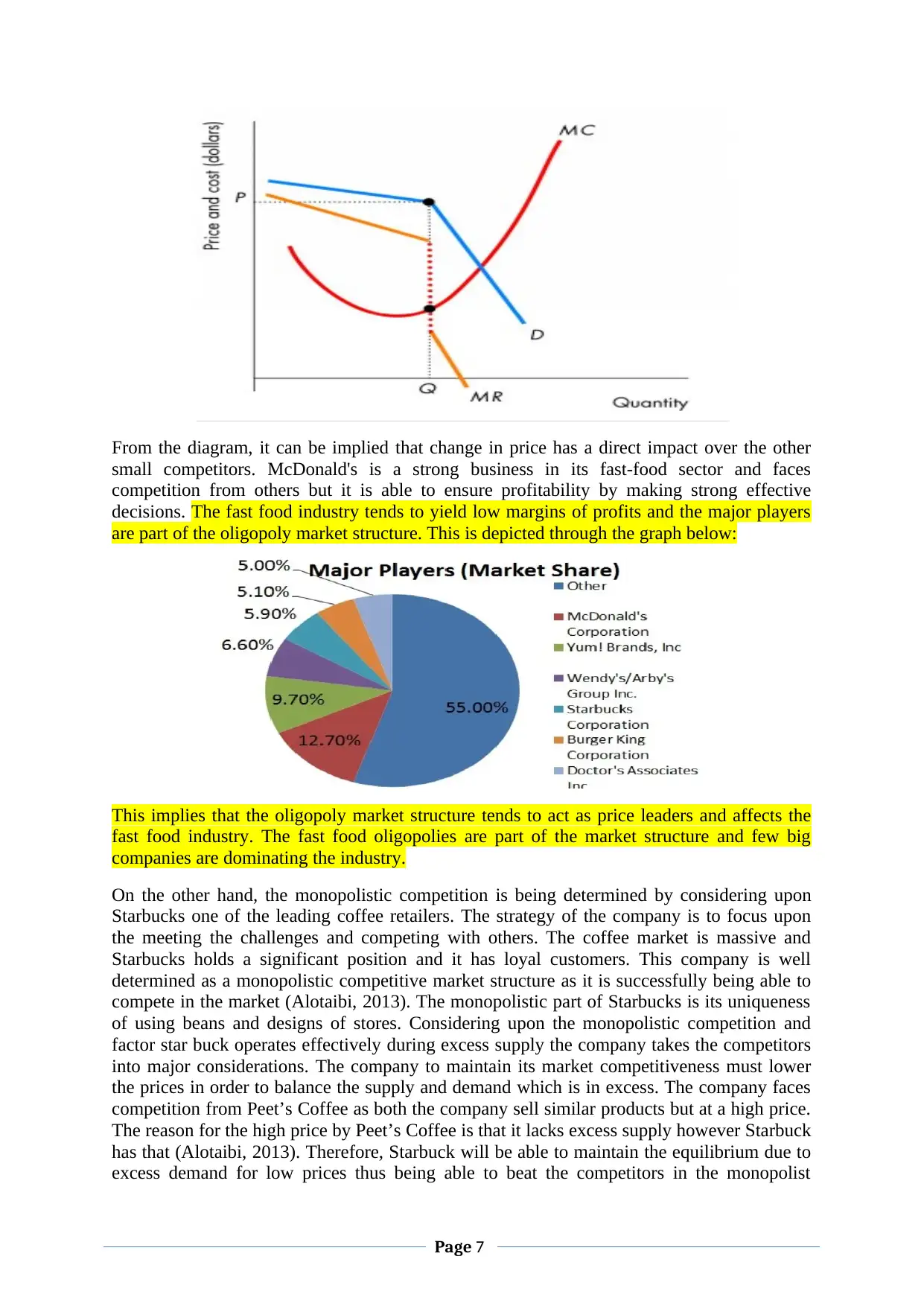
From the diagram, it can be implied that change in price has a direct impact over the other
small competitors. McDonald's is a strong business in its fast-food sector and faces
competition from others but it is able to ensure profitability by making strong effective
decisions. The fast food industry tends to yield low margins of profits and the major players
are part of the oligopoly market structure. This is depicted through the graph below:
This implies that the oligopoly market structure tends to act as price leaders and affects the
fast food industry. The fast food oligopolies are part of the market structure and few big
companies are dominating the industry.
On the other hand, the monopolistic competition is being determined by considering upon
Starbucks one of the leading coffee retailers. The strategy of the company is to focus upon
the meeting the challenges and competing with others. The coffee market is massive and
Starbucks holds a significant position and it has loyal customers. This company is well
determined as a monopolistic competitive market structure as it is successfully being able to
compete in the market (Alotaibi, 2013). The monopolistic part of Starbucks is its uniqueness
of using beans and designs of stores. Considering upon the monopolistic competition and
factor star buck operates effectively during excess supply the company takes the competitors
into major considerations. The company to maintain its market competitiveness must lower
the prices in order to balance the supply and demand which is in excess. The company faces
competition from Peet’s Coffee as both the company sell similar products but at a high price.
The reason for the high price by Peet’s Coffee is that it lacks excess supply however Starbuck
has that (Alotaibi, 2013). Therefore, Starbuck will be able to maintain the equilibrium due to
excess demand for low prices thus being able to beat the competitors in the monopolist
Page 7
small competitors. McDonald's is a strong business in its fast-food sector and faces
competition from others but it is able to ensure profitability by making strong effective
decisions. The fast food industry tends to yield low margins of profits and the major players
are part of the oligopoly market structure. This is depicted through the graph below:
This implies that the oligopoly market structure tends to act as price leaders and affects the
fast food industry. The fast food oligopolies are part of the market structure and few big
companies are dominating the industry.
On the other hand, the monopolistic competition is being determined by considering upon
Starbucks one of the leading coffee retailers. The strategy of the company is to focus upon
the meeting the challenges and competing with others. The coffee market is massive and
Starbucks holds a significant position and it has loyal customers. This company is well
determined as a monopolistic competitive market structure as it is successfully being able to
compete in the market (Alotaibi, 2013). The monopolistic part of Starbucks is its uniqueness
of using beans and designs of stores. Considering upon the monopolistic competition and
factor star buck operates effectively during excess supply the company takes the competitors
into major considerations. The company to maintain its market competitiveness must lower
the prices in order to balance the supply and demand which is in excess. The company faces
competition from Peet’s Coffee as both the company sell similar products but at a high price.
The reason for the high price by Peet’s Coffee is that it lacks excess supply however Starbuck
has that (Alotaibi, 2013). Therefore, Starbuck will be able to maintain the equilibrium due to
excess demand for low prices thus being able to beat the competitors in the monopolist
Page 7
Paraphrase This Document
Need a fresh take? Get an instant paraphrase of this document with our AI Paraphraser
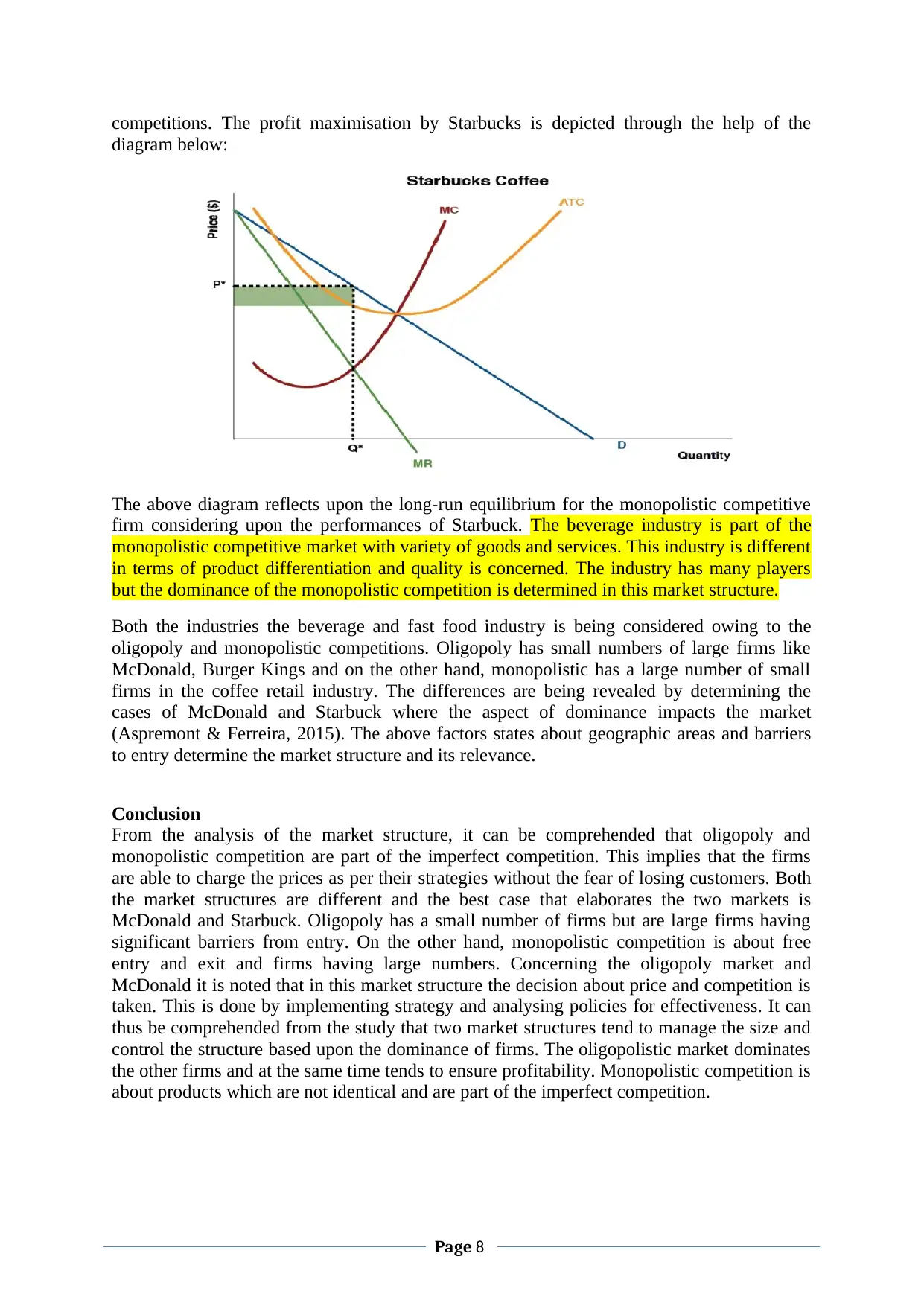
competitions. The profit maximisation by Starbucks is depicted through the help of the
diagram below:
The above diagram reflects upon the long-run equilibrium for the monopolistic competitive
firm considering upon the performances of Starbuck. The beverage industry is part of the
monopolistic competitive market with variety of goods and services. This industry is different
in terms of product differentiation and quality is concerned. The industry has many players
but the dominance of the monopolistic competition is determined in this market structure.
Both the industries the beverage and fast food industry is being considered owing to the
oligopoly and monopolistic competitions. Oligopoly has small numbers of large firms like
McDonald, Burger Kings and on the other hand, monopolistic has a large number of small
firms in the coffee retail industry. The differences are being revealed by determining the
cases of McDonald and Starbuck where the aspect of dominance impacts the market
(Aspremont & Ferreira, 2015). The above factors states about geographic areas and barriers
to entry determine the market structure and its relevance.
Conclusion
From the analysis of the market structure, it can be comprehended that oligopoly and
monopolistic competition are part of the imperfect competition. This implies that the firms
are able to charge the prices as per their strategies without the fear of losing customers. Both
the market structures are different and the best case that elaborates the two markets is
McDonald and Starbuck. Oligopoly has a small number of firms but are large firms having
significant barriers from entry. On the other hand, monopolistic competition is about free
entry and exit and firms having large numbers. Concerning the oligopoly market and
McDonald it is noted that in this market structure the decision about price and competition is
taken. This is done by implementing strategy and analysing policies for effectiveness. It can
thus be comprehended from the study that two market structures tend to manage the size and
control the structure based upon the dominance of firms. The oligopolistic market dominates
the other firms and at the same time tends to ensure profitability. Monopolistic competition is
about products which are not identical and are part of the imperfect competition.
Page 8
diagram below:
The above diagram reflects upon the long-run equilibrium for the monopolistic competitive
firm considering upon the performances of Starbuck. The beverage industry is part of the
monopolistic competitive market with variety of goods and services. This industry is different
in terms of product differentiation and quality is concerned. The industry has many players
but the dominance of the monopolistic competition is determined in this market structure.
Both the industries the beverage and fast food industry is being considered owing to the
oligopoly and monopolistic competitions. Oligopoly has small numbers of large firms like
McDonald, Burger Kings and on the other hand, monopolistic has a large number of small
firms in the coffee retail industry. The differences are being revealed by determining the
cases of McDonald and Starbuck where the aspect of dominance impacts the market
(Aspremont & Ferreira, 2015). The above factors states about geographic areas and barriers
to entry determine the market structure and its relevance.
Conclusion
From the analysis of the market structure, it can be comprehended that oligopoly and
monopolistic competition are part of the imperfect competition. This implies that the firms
are able to charge the prices as per their strategies without the fear of losing customers. Both
the market structures are different and the best case that elaborates the two markets is
McDonald and Starbuck. Oligopoly has a small number of firms but are large firms having
significant barriers from entry. On the other hand, monopolistic competition is about free
entry and exit and firms having large numbers. Concerning the oligopoly market and
McDonald it is noted that in this market structure the decision about price and competition is
taken. This is done by implementing strategy and analysing policies for effectiveness. It can
thus be comprehended from the study that two market structures tend to manage the size and
control the structure based upon the dominance of firms. The oligopolistic market dominates
the other firms and at the same time tends to ensure profitability. Monopolistic competition is
about products which are not identical and are part of the imperfect competition.
Page 8
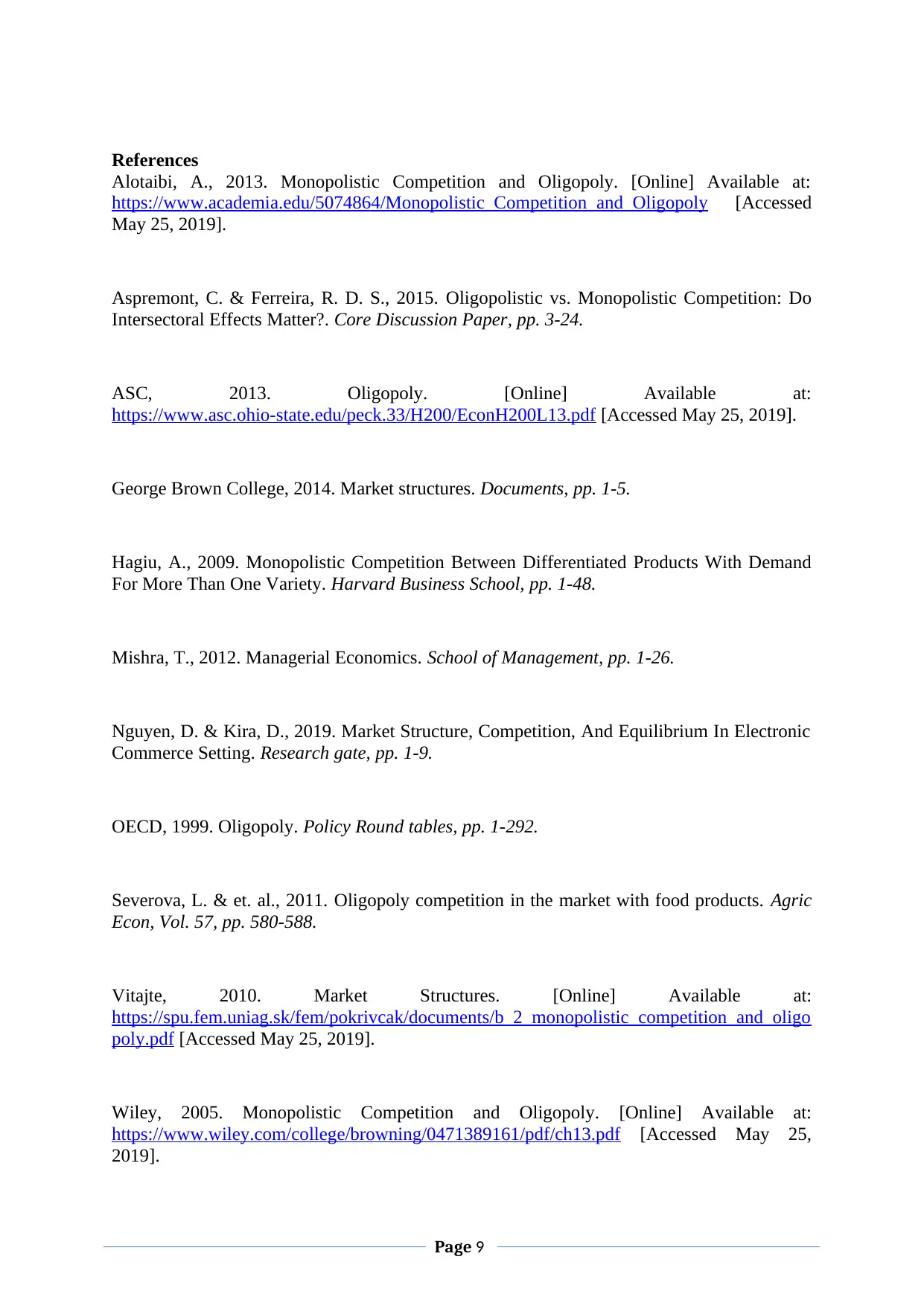
References
Alotaibi, A., 2013. Monopolistic Competition and Oligopoly. [Online] Available at:
https://www.academia.edu/5074864/Monopolistic_Competition_and_Oligopoly [Accessed
May 25, 2019].
Aspremont, C. & Ferreira, R. D. S., 2015. Oligopolistic vs. Monopolistic Competition: Do
Intersectoral Effects Matter?. Core Discussion Paper, pp. 3-24.
ASC, 2013. Oligopoly. [Online] Available at:
https://www.asc.ohio-state.edu/peck.33/H200/EconH200L13.pdf [Accessed May 25, 2019].
George Brown College, 2014. Market structures. Documents, pp. 1-5.
Hagiu, A., 2009. Monopolistic Competition Between Differentiated Products With Demand
For More Than One Variety. Harvard Business School, pp. 1-48.
Mishra, T., 2012. Managerial Economics. School of Management, pp. 1-26.
Nguyen, D. & Kira, D., 2019. Market Structure, Competition, And Equilibrium In Electronic
Commerce Setting. Research gate, pp. 1-9.
OECD, 1999. Oligopoly. Policy Round tables, pp. 1-292.
Severova, L. & et. al., 2011. Oligopoly competition in the market with food products. Agric
Econ, Vol. 57, pp. 580-588.
Vitajte, 2010. Market Structures. [Online] Available at:
https://spu.fem.uniag.sk/fem/pokrivcak/documents/b_2_monopolistic_competition_and_oligo
poly.pdf [Accessed May 25, 2019].
Wiley, 2005. Monopolistic Competition and Oligopoly. [Online] Available at:
https://www.wiley.com/college/browning/0471389161/pdf/ch13.pdf [Accessed May 25,
2019].
Page 9
Alotaibi, A., 2013. Monopolistic Competition and Oligopoly. [Online] Available at:
https://www.academia.edu/5074864/Monopolistic_Competition_and_Oligopoly [Accessed
May 25, 2019].
Aspremont, C. & Ferreira, R. D. S., 2015. Oligopolistic vs. Monopolistic Competition: Do
Intersectoral Effects Matter?. Core Discussion Paper, pp. 3-24.
ASC, 2013. Oligopoly. [Online] Available at:
https://www.asc.ohio-state.edu/peck.33/H200/EconH200L13.pdf [Accessed May 25, 2019].
George Brown College, 2014. Market structures. Documents, pp. 1-5.
Hagiu, A., 2009. Monopolistic Competition Between Differentiated Products With Demand
For More Than One Variety. Harvard Business School, pp. 1-48.
Mishra, T., 2012. Managerial Economics. School of Management, pp. 1-26.
Nguyen, D. & Kira, D., 2019. Market Structure, Competition, And Equilibrium In Electronic
Commerce Setting. Research gate, pp. 1-9.
OECD, 1999. Oligopoly. Policy Round tables, pp. 1-292.
Severova, L. & et. al., 2011. Oligopoly competition in the market with food products. Agric
Econ, Vol. 57, pp. 580-588.
Vitajte, 2010. Market Structures. [Online] Available at:
https://spu.fem.uniag.sk/fem/pokrivcak/documents/b_2_monopolistic_competition_and_oligo
poly.pdf [Accessed May 25, 2019].
Wiley, 2005. Monopolistic Competition and Oligopoly. [Online] Available at:
https://www.wiley.com/college/browning/0471389161/pdf/ch13.pdf [Accessed May 25,
2019].
Page 9
⊘ This is a preview!⊘
Do you want full access?
Subscribe today to unlock all pages.

Trusted by 1+ million students worldwide

Page
10
10
1 out of 10
Related Documents
Your All-in-One AI-Powered Toolkit for Academic Success.
+13062052269
info@desklib.com
Available 24*7 on WhatsApp / Email
![[object Object]](/_next/static/media/star-bottom.7253800d.svg)
Unlock your academic potential
Copyright © 2020–2025 A2Z Services. All Rights Reserved. Developed and managed by ZUCOL.



